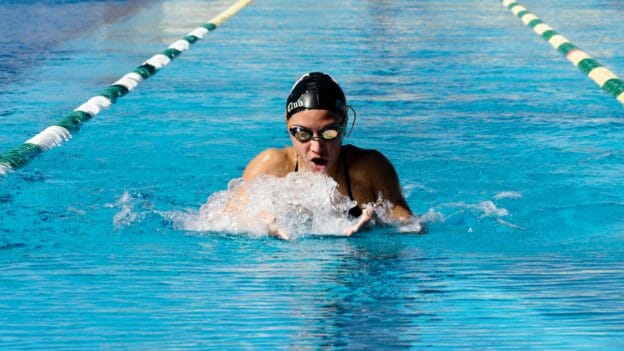Two new Metrics to evaluate Breaststroke
Adam Peaty and Lilly King have rewritten the rules on breaststroke technique. They both pull widely, elevate the shoulders extremely high, crash down hard with the upper body and head, which is timed exquisitely with the propulsion from their kicks. Oh, and did I forget to mention that their stroke rates are faster than nearly everyone else’s?
We call the new technique the Power Breaststroke. It is much easier to describe than it is to teach or learn. Part of the reason for that is that Power Breaststroke requires, as Indiana University Head Coach Ray Looze describes, lightning-fast legs. Not everyone has that ability. Since the kick contributes the majority of the breaststroker’s speed, Power Breaststroke also requires that they use a technique that will not significantly slow them down after the propulsive kick occurs.
The lightning-fast legs of Power Breaststroke are required to perfect the timing of the technique. Breaststroke is the most timing-sensitive stroke since the pull and kick occur independently. The kick, which is already the most important source of propulsion, becomes even more powerful when its peak propulsion coincides with the body and head crashing down into the water. That is called coupling, but it is a challenge to do in breaststroke!
For that to happen, the upper body and shoulders need to rise out of the water like the mythical Phoenix. The lower back needs to extend or arch fully, bending the body to nearly right angles. Then, the upper body and head need to come crashing down aggressively, with the head leading the way. By the time the body reaches the water on the way down, to achieve coupling, the legs have to be in propulsion mode. The closer they are to peak propulsion, the better. The result is a tremendous surge forward, assuming the swimmer generates decent propulsion with the kick.
When a breaststroker elevates out of the water as high as possible, it accomplishes two things. First, it buys the breaststroker a little more time until the body hits the water. Second, it increases the kinetic energy of the body coming down. The higher the swimmer climbs, the harder he or she falls.
One metric that we now use in Velocity Meter technology to evaluate breaststrokers is the time between peak propulsion from the pull and peak propulsion from the kick. In effect, that measures the breaststroker’s leg speed during the kicking cycle. With elite breaststrokers, like Peaty, King, or Rebecca Soni, we believe that time is around .5 seconds. If it takes much longer than that, even a few hundredths of a second, the swimmer misses the boat. The coupling energy of the upper body is wasted because there is no kicking propulsion going on when the body hits the water. Shortly after the body hits the water, its kinetic energy goes to zero.
A second metric that we feel is important in breaststroke is the percentage of velocity lost after the kick. Essentially, that is a measurement of how well the swimmer is streamlining after the kick at both ends of the body. In other words, how well the swimmer retains the speed from the kick. The metric is different than distance per stroke, which also measures propulsion. This one just focuses on holding speed by reducing frontal drag.
With some of the elite breaststrokers we have tested, like Olympian Mike Alexandrov, we have found that losing 20-30% of the speed after the kick is good. With breaststrokers using poor technique, we often find that the swimmer will lose over 50% of his or her speed after the kick. I have seen as high at 80% loss of speed! Ouch.
This week, in our breaststroke video series, we continue with some of the techniques we use to help the breaststroker’s leg speed, so they can capture their body’s energy. We also demonstrate how to retain the speed after the kick using good streamlining techniques. We hope you will join us in Lane 2 or Lane 3 for our instructional videos.
Yours in Swimming,
Gary Sr.

